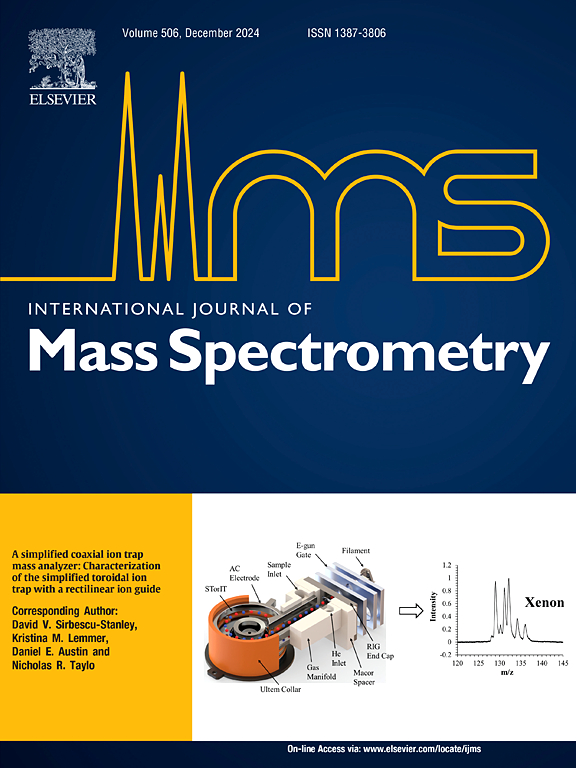新型双聚焦热电离质谱仪的研制
IF 1.7
3区 化学
Q3 PHYSICS, ATOMIC, MOLECULAR & CHEMICAL
引用次数: 0
摘要
与传统的单聚焦磁质分析仪(如Triton, Phoenix, Nu TIMS等)不同,新开发的双聚焦热电离质谱仪(DF-TIMS)通过减轻加速高压噪声和漂移来提高系统的稳定性。该仪器采用尼尔-约翰逊型双聚焦质量分析仪,包括一个半径为250毫米的层压磁铁和一个半径为350毫米的圆柱形静电分析仪(ESA),可实现560毫米的质量弥散。它配备了16个法拉第杯和4个全尺寸离散dynode二级电子倍增器(SEM),结合可变色散双四极变焦光学,允许多次收集高达20%质量色散的同位素,如锂,硼和钙的同位素。此外,一个紧凑和先进的缓速过滤器提高了丰度的灵敏度,从<;2 ppm至<;5磅。自动调谐和测量提高了正离子和负离子的效率。DF-TIMS的源狭缝为0.2 mm,接收狭缝为1 mm,分辨率超过470,峰值形状因子低于0.3。由于双聚焦设计,系统稳定性低于15 ppm/30分钟。每个法拉第杯的工作动态范围为0-50 V, RMS噪声(4s积分,1011 Ω高电阻)低于20 μV,基线漂移低于1 × 10−16 a /h。该仪器已被广泛应用,为5 ppm以下的锶和钕测量提供内部精度和外部精度,满足核科学和地球科学中严格的同位素比分析要求。本文章由计算机程序翻译,如有差异,请以英文原文为准。

The development of a novel double-focusing thermal ionization mass spectrometer
Unlike traditional Thermal Ionization Mass Spectrometers (TIMS) with single-focusing magnetic mass analyzers (such as Triton, Phoenix, Nu TIMS, etc.), a newly developed Double-Focusing Thermal Ionization Mass Spectrometer (DF-TIMS) enhances the system stability by mitigating accelerating high-voltage noise and drift. Featuring a Nier-Johnson type double-focusing mass analyzer, the instrument includes a laminated magnet with a 250 mm radius and a cylindrical Electrostatic Analyzer (ESA) with a 350 mm radius, achieving a mass dispersion of 560 mm. It is equipped with of 16 Faraday cups and 4 full-size discrete dynode secondary electron multipliers (SEM), combined with variable dispersion double quadrupole zoom optics, allowing for multi-collection of isotopes with up to 20 % mass dispersion, such as isotopes of Lithium, Boron and Calcium. Additionally, a compact and advanced Retarding Filter enhances abundance sensitivity from < 2 ppm to < 5 ppb. Automated tuning and measurement improve efficiency for both positive and negative ions. With a 0.2 mm source slit and a 1 mm receiving slit, DF-TIMS achieves a resolution over 470 and a peak shape factor below 0.3. System stability is less than 15 ppm/30 min credit to the double-focusing design. Each Faraday cup operates with a dynamic range of 0–50 V, featuring Root Mean Square (RMS) noise (4s integration, 1011 Ω high resistance) under 20 μV and baseline drift below 1 × 10−16 A/h. The instrument has been applied extensively, delivering internal precision and external precision for Strontium and Neodymium measurements under 5 ppm, meeting stringent isotopic ratio analysis requirements in nuclear science and geoscience.
求助全文
通过发布文献求助,成功后即可免费获取论文全文。
去求助
来源期刊
CiteScore
3.60
自引率
5.60%
发文量
145
审稿时长
71 days
期刊介绍:
The journal invites papers that advance the field of mass spectrometry by exploring fundamental aspects of ion processes using both the experimental and theoretical approaches, developing new instrumentation and experimental strategies for chemical analysis using mass spectrometry, developing new computational strategies for data interpretation and integration, reporting new applications of mass spectrometry and hyphenated techniques in biology, chemistry, geology, and physics.
Papers, in which standard mass spectrometry techniques are used for analysis will not be considered.
IJMS publishes full-length articles, short communications, reviews, and feature articles including young scientist features.

 求助内容:
求助内容: 应助结果提醒方式:
应助结果提醒方式:


